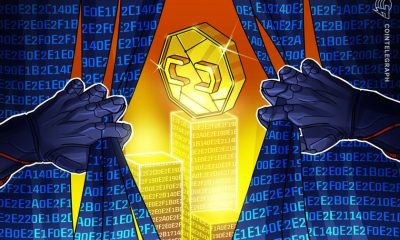Blockchain
Cointelegraph Consulting: Going down the Metaverse

The metaverse allows people to interact with one another, digital objects, and the physical world through their avatar in a virtual environment.
As NFT sales appear reanimated after a nearly two-month dry spell from its apex in May, a particular NFT application is gaining popularity more than ever: Metaverses. Metaverses have gained its fair share of media attention lately, with big moves coming from companies like Facebook and Epic games. However, not everyone — even those who have been in crypto for a long time — has caught on to what metaverses are despite the hype. But as more companies, celebrities, and artists venture into the space, it has become another domain that deserves some thorough consideration.
The metaverse is a network of virtual environments in which people can interact with each other, digital objects, and the physical world through their avatar. While definitions of the metaverse vary, they orbit around technologies including VR, AR, digital twins, and blockchain. Herman Narula, CEO of Improbable, describes the metaverse as “something more than a game but less than the real world. The metaverse is to virtual worlds as a website is to the internet.”
Metaverse bandwagon
For weeks, Mark Zuckerberg has been beating the drum for metaverses. The Facebook founder views virtual worlds as the next iteration of human interaction online. Zuckerberg sees Facebook transitioning from a social media firm with a set of connected applications to a metaverse company with a set of interconnected experiences. And its recent move to introduce Horizon Workrooms is a step in that direction. It’s also in a prime spot to run after its metaverse objectives since it has invested heavily in VR technology for several years.
Another one bursting onto the scene is game and software developer Epic Games. Epic Games, of course, already has something to show for when it comes to metaverses with the successful virtual concerts of Ariana Grande, Travis Scott, and Marshmello that was held inside its flagship game, Fortnite. And the $1 billion in funding that it received in April with an additional $200 million deal from Sony Group will help it pursue long-term growth opportunities with metaverses, especially as it is already remodeling the future of live events.
Why the metaverse?
The metaverse offers a vastly unique experience for everyone. It’s a way for artists to connect with fans more interactively and perhaps individually, which is a step up from the live stream format delivered by artists like Post Malone, Dua Lipa, Gorillaz, and many others when the pandemic struck in 2020.
On the other hand, Facebook’s Horizon Workroom is geared towards replacing boring Zoom call meetings with a more interactive environment, a virtual conference room, if you will, for remote workers. Others also see a wide variety of applications that metaverse is going to be useful for. Education systems, for one, can benefit by allowing students, particularly in the medical field, for simulation training as opposed to just a one-way communication where teachers merely deliver the lessons to the students.
Metaverses and NFTs
The tie-in between metaverses and nonfungible tokens (NFTs) comes from NFTs’ capability of adding a certificate of ownership or authenticity to the assets belonging to the digital world. Projects like Decentraland, The Sandbox, Landemic, CryptoVoxels, and SuperWorld involve acquiring a piece of this digital asset, which is primarily virtual land. NFTs help in verifying its uniqueness, and even its provenance.
For instance, Decentraland is based on the Ethereum blockchain and uses ERC-721 tokens called LAND to facilitate trading plots of virtual lands called parcels. This makes each land distinct and helps users establish ownership of a piece of the entire Decentraland real estate. This is built on its consensus layer, which maintains a ledger that tracks the ownership of each parcel.
LAND tokens enable owners to do various things within their digital real estate, like hosting games or experiences, organizing contests and events, or even renting it. The same concept applies to The Sandbox, the second-largest metaverse NFT project in terms of sales to Decentraland.
Download the 29th issue of Cointelegraph Consulting Bi-weekly Newsletter in full, complete with charts, market signals, as well as news and overviews of fundraising events.
Metaverses and cryptocurrencies
Cryptocurrencies play the medium of exchange within the metaverse, allowing users to exchange virtual goods. The two metaverses mentioned above enable players to transact using cryptocurrencies. Decentraland’s ERC-20 based token, MANNA, is the legal tender for users to purchase plots of digital land and SAND tokens for The Sandbox. Such coins also give users the opportunity to participate in its development.
Users can use MANNA tokens to vote on policy updates, land auctions, and subsidies for new developments on Decentraland, while users can use SAND tokens for more or less the same purpose. Moreover, cryptocurrencies can further open up the possibility of transacting goods from different games or metaverses on interoperable marketplaces.
Growth of Metaverses
At this stage, metaverses haven’t reached their full potential, and companies are just beginning to explore the ways they could penetrate the space. Facebook and Epic games are just the two most recent examples of big names jumping on the bandwagon. However, companies like Microsoft and Amazon are also getting in on the act. Amazon, in particular, is developing a virtual “Amazon mall” where users can shop and interact with the products they want to buy. But whether or not these are going to support NFTs is still uncertain and maybe even unlikely.
Nonetheless, NFT sales from metaverses are gradually gaining a strong foothold against other categories. In the second quarter, its weekly sales topped $8 million at one point.

Source: Nonfungible.com
Total sales from 2017 to August 2021 amounted to $138 million, which is enough to take a 6.77% share of NFT sales by category. This puts the Metaverse NFT category at third place in NFT sales behind digital collectibles and artwork.

Source: Nonfungible.com
And as more and more well-known personalities and big companies take part in the trend, the numbers could very well improve before the end of the year. The growth of metaverses and NFTs, in general, is unprecedented, especially in 2021. Sales of NFTs in the metaverse are already up by 428% from 2020 and averaged 149% growth in the past four years. If this explosive growth keeps the same pace, it would not be hard to see sales breach the $120-million mark by early 2022.

Cointelegraph’s Market Insights Newsletter shares our knowledge on the fundamentals that move the digital asset market. The newsletter dives into the latest data on social media sentiment, on-chain metrics, and derivatives.
We also review the industry’s most important news, including mergers and acquisitions, changes in the regulatory landscape, and enterprise blockchain integrations. Sign up now to be the first to receive these insights. All past editions of Market Insights are also available on Cointelegraph.com.

















